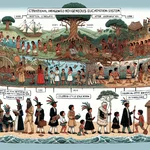Welcome to our IELTS Reading practice session focusing on “The Impact of Globalization on Language Education Policies.” As an experienced IELTS instructor, I’ve crafted this comprehensive practice test to help you prepare for the reading section of the IELTS exam. Let’s dive into this fascinating topic and enhance your reading skills!
 Globalization and Language Education
Globalization and Language Education
Introduction to the Topic
Globalization has profoundly influenced various aspects of our lives, including education systems worldwide. This practice test explores how globalization shapes language education policies, affecting curriculum design, teaching methodologies, and linguistic diversity in schools. As you work through these passages, pay close attention to the intricate relationships between global trends and local language education strategies.
IELTS Reading Practice Test
Passage 1 (Easy Text)
The Global Language Landscape
In recent decades, the world has witnessed an unprecedented level of interconnectedness, largely due to advancements in technology and increased international trade. This phenomenon, known as globalization, has had a profound impact on various aspects of society, including language education policies around the globe. As countries strive to prepare their citizens for a more interconnected world, many have begun to reassess their approach to language education.
One of the most noticeable effects of globalization on language education has been the rise of English as a global lingua franca. Many countries have responded to this trend by implementing policies that prioritize English language instruction in their schools. For instance, countries like South Korea and Japan have introduced English classes at increasingly younger ages, with some schools offering English immersion programs as early as kindergarten.
However, this emphasis on English has not come without controversy. Critics argue that the push for English proficiency may come at the expense of native language development and cultural preservation. In response, some countries have adopted bilingual education models that aim to balance the acquisition of English with the maintenance of local languages and cultures.
Another significant trend in language education policies is the growing recognition of multilingualism as an asset in the global economy. Many European countries, for example, have implemented policies that encourage students to learn multiple languages throughout their school years. The European Union’s “mother tongue plus two” policy recommends that all EU citizens learn two languages in addition to their native tongue.
As globalization continues to shape our world, language education policies will likely continue to evolve. The challenge for policymakers lies in striking a balance between preparing students for global participation and preserving linguistic and cultural diversity.
Questions 1-5
Do the following statements agree with the information given in the reading passage?
Write:
TRUE if the statement agrees with the information
FALSE if the statement contradicts the information
NOT GIVEN if there is no information on this
- Globalization has had no effect on language education policies.
- English has become increasingly important in global communication.
- All countries have welcomed the emphasis on English language education without any concerns.
- The European Union encourages its citizens to learn three languages in total.
- Globalization has led to the extinction of many local languages.
Questions 6-10
Complete the sentences below.
Choose NO MORE THAN TWO WORDS from the passage for each answer.
- Many countries have begun to __ their approach to language education due to globalization.
- Some schools in South Korea and Japan offer English __ programs for very young children.
- Critics worry that focusing on English may negatively impact __ and cultural preservation.
- Some countries have adopted __ education models to balance English acquisition with local language maintenance.
- The challenge for policymakers is to strike a __ between global participation and linguistic diversity.
Passage 2 (Medium Text)
The Shifting Paradigms of Language Education in a Globalized World
The advent of globalization has ushered in a new era of interconnectedness, profoundly altering the landscape of language education worldwide. As nations grapple with the demands of an increasingly integrated global economy, language education policies have undergone significant transformations. These changes reflect a complex interplay between economic imperatives, cultural preservation, and the need for effective cross-cultural communication.
One of the most salient trends in language education policies has been the widespread adoption of English as a core subject in many non-English speaking countries. This shift is largely driven by the perception of English as a gateway to economic opportunities in the global marketplace. Countries such as China, Brazil, and the United Arab Emirates have invested heavily in English language education, often starting at the primary school level. However, this emphasis on English has sparked debates about linguistic imperialism and the potential erosion of local languages and cultures.
In response to these concerns, many countries have adopted nuanced approaches to language education that aim to strike a balance between global competitiveness and cultural preservation. For instance, Singapore’s bilingual education policy mandates that students learn both English and their mother tongue (typically Mandarin, Malay, or Tamil). This approach seeks to equip students with the linguistic tools necessary for global engagement while simultaneously reinforcing their cultural identities.
The impact of globalization on language education extends beyond the realm of policy-making to influence pedagogical approaches and curriculum design. There has been a notable shift towards communicative language teaching methodologies that prioritize real-world language use over rote memorization of grammar rules. This trend reflects the growing recognition that language proficiency in a globalized world requires not just linguistic knowledge, but also intercultural competence.
Moreover, advancements in technology have revolutionized language learning, offering unprecedented access to authentic language materials and opportunities for virtual immersion. Language education policies in many countries now incorporate digital literacy components, acknowledging the integral role of technology in both language acquisition and global communication.
Despite these global trends, it is important to note that the impact of globalization on language education policies is not uniform across all contexts. Local factors such as historical legacies, demographic compositions, and geopolitical considerations continue to shape language education policies in unique ways. For example, post-colonial nations may prioritize the revitalization of indigenous languages alongside the teaching of global languages.
As we move further into the 21st century, language education policies will likely continue to evolve in response to the ever-changing dynamics of globalization. The challenge for policymakers and educators alike lies in developing approaches that prepare learners for global citizenship while valuing linguistic diversity and cultural heritage.
Questions 11-15
Choose the correct letter, A, B, C, or D.
-
According to the passage, globalization has:
A) Had no impact on language education
B) Only affected English-speaking countries
C) Significantly changed language education policies worldwide
D) Decreased the importance of language education -
The widespread adoption of English in non-English speaking countries is primarily driven by:
A) Cultural imperialism
B) Political pressure from English-speaking nations
C) The desire to preserve local languages
D) Economic opportunities in the global market -
Singapore’s bilingual education policy aims to:
A) Eliminate local languages
B) Focus solely on English education
C) Balance global competitiveness with cultural preservation
D) Promote linguistic imperialism -
The shift towards communicative language teaching methodologies reflects:
A) A preference for traditional teaching methods
B) A focus on grammar rules over practical language use
C) The need for both linguistic knowledge and intercultural competence
D) A disregard for real-world language applications -
The passage suggests that the impact of globalization on language education policies is:
A) Uniform across all countries
B) Influenced by local factors and contexts
C) Only relevant in developed countries
D) Detrimental to all local languages
Questions 16-20
Complete the summary below.
Choose NO MORE THAN TWO WORDS from the passage for each answer.
Globalization has significantly impacted language education policies worldwide. Many countries have adopted English as a core subject, viewing it as a (16) __ to economic opportunities. However, this has raised concerns about (17) __ and the potential loss of local cultures. In response, some countries have implemented (18) __ approaches to balance global competitiveness and cultural preservation. The influence of globalization extends to teaching methods, with a shift towards (19) __ that emphasize practical language use. Additionally, technology has revolutionized language learning, offering opportunities for (20) __ and access to authentic materials.
Passage 3 (Hard Text)
The Dialectics of Globalization and Language Education: Policy Implications and Future Trajectories
The inexorable march of globalization has precipitated a paradigm shift in language education policies worldwide, engendering a complex tapestry of responses that reflect the tension between global integration and local particularism. As nation-states navigate the choppy waters of an increasingly interconnected global economy, language education has emerged as a critical locus of policy intervention, serving as both a conduit for globalization and a bulwark against cultural homogenization.
The ascendancy of English as the de facto lingua franca of global commerce and academic discourse has catalyzed widespread reforms in language education policies across the globe. Many countries have implemented measures to bolster English language instruction, often at the expense of other foreign languages or even indigenous tongues. This trend is particularly pronounced in East Asian nations such as China, Japan, and South Korea, where English proficiency is increasingly viewed as a sine qua non for economic advancement and international competitiveness.
However, this English-centric approach has not gone unchallenged. Critics argue that it perpetuates a form of linguistic imperialism that marginalizes local languages and cultural identities. In response, some countries have adopted more nuanced policies that seek to reconcile the exigencies of globalization with the imperative of cultural preservation. The European Union’s promotion of multilingualism through its “mother tongue plus two” policy exemplifies this balanced approach, aiming to foster linguistic diversity while equipping citizens with the language skills necessary for participation in the global arena.
The impact of globalization on language education extends beyond policy formulation to influence pedagogical practices and curriculum design. There has been a discernible shift towards communicative and task-based approaches that prioritize functional language use over abstract linguistic knowledge. This paradigm shift reflects a growing recognition that effective communication in a globalized world requires not only linguistic proficiency but also intercultural competence and the ability to navigate diverse cultural contexts.
Moreover, the digital revolution has profoundly altered the landscape of language education, offering unprecedented opportunities for authentic language exposure and virtual immersion. Many countries have responded by incorporating digital literacy components into their language education policies, acknowledging the integral role of technology in both language acquisition and global communication. The proliferation of Massive Open Online Courses (MOOCs) and language learning apps has democratized access to language education, challenging traditional notions of linguistic gatekeeping.
However, it would be remiss to view the impact of globalization on language education policies as a unidirectional or homogeneous process. Local factors such as sociolinguistic landscapes, historical legacies, and geopolitical considerations continue to shape policy responses in diverse and sometimes unexpected ways. For instance, in post-colonial contexts, language education policies often reflect a complex negotiation between the linguistic heritage of colonialism, the pragmatic demands of globalization, and the imperative of nation-building.
Furthermore, the COVID-19 pandemic has added another layer of complexity to the globalization-language education nexus. The abrupt shift to online learning has accelerated the adoption of digital language learning tools but has also exacerbated existing inequalities in access to quality language education. This development underscores the need for policies that address not only linguistic and cultural considerations but also issues of digital equity and accessibility.
As we look to the future, it is clear that the dialectic between globalization and language education will continue to evolve. Emerging technologies such as artificial intelligence and virtual reality promise to revolutionize language learning, potentially rendering traditional language education paradigms obsolete. At the same time, growing awareness of the importance of linguistic diversity for cognitive development and cultural heritage preservation may lead to a resurgence of interest in multilingual education models.
In conclusion, the impact of globalization on language education policies represents a complex and ongoing process of negotiation between global forces and local realities. As policymakers and educators grapple with these challenges, the key to success may lie in developing flexible and adaptive approaches that can respond to the ever-changing dynamics of our interconnected world while safeguarding linguistic diversity and cultural heritage.
Questions 21-26
Complete the sentences below.
Choose NO MORE THAN TWO WORDS from the passage for each answer.
- Language education serves as both a __ for globalization and a defense against cultural homogenization.
- In East Asian countries, English proficiency is seen as a __ for economic advancement and international competitiveness.
- Critics argue that an English-centric approach perpetuates a form of __ that marginalizes local languages and cultural identities.
- The European Union’s language policy aims to foster linguistic diversity while equipping citizens with skills for participation in the __.
- There has been a shift towards teaching approaches that prioritize __ over abstract linguistic knowledge.
- The proliferation of MOOCs and language learning apps has challenged traditional notions of __.
Questions 27-33
Do the following statements agree with the information given in the reading passage?
Write:
TRUE if the statement agrees with the information
FALSE if the statement contradicts the information
NOT GIVEN if there is no information on this
- Globalization has had a uniform impact on language education policies across all countries.
- The digital revolution has created new opportunities for language learning and exposure to authentic language use.
- Local factors such as sociolinguistic landscapes and historical legacies have no influence on language education policies.
- The COVID-19 pandemic has highlighted issues of digital equity in language education.
- Artificial intelligence and virtual reality are expected to make traditional language education completely obsolete.
- There is growing awareness of the importance of linguistic diversity for cognitive development.
- All countries have successfully balanced the demands of globalization with the preservation of local languages and cultures.
Questions 34-40
Choose the correct letter, A, B, C, or D.
-
According to the passage, the tension in language education policies is between:
A) Global integration and local particularism
B) English and other foreign languages
C) Digital and traditional learning methods
D) Primary and secondary education -
The “mother tongue plus two” policy of the European Union aims to:
A) Promote only European languages
B) Eliminate the use of local languages
C) Foster linguistic diversity while preparing for global participation
D) Focus solely on English language education -
The shift towards communicative and task-based approaches in language teaching reflects:
A) A preference for theoretical linguistic knowledge
B) A focus on grammar-based instruction
C) A recognition of the need for practical communication skills
D) A disregard for cultural competence -
The digital revolution in language education has:
A) Had no impact on language learning
B) Only benefited wealthy countries
C) Democratized access to language education
D) Eliminated the need for traditional classrooms -
In post-colonial contexts, language education policies often reflect:
A) A simple continuation of colonial language policies
B) A complete rejection of colonial languages
C) A complex negotiation between various linguistic and cultural factors
D) A focus solely on indigenous languages -
The COVID-19 pandemic has:
A) Had no effect on language education
B) Improved access to language education for all students
C) Highlighted and exacerbated inequalities in language education access
D) Eliminated the need for language education policies -
The passage suggests that the future of language education policies will likely:
A) Remain unchanged from current policies
B) Focus exclusively on English language education
C) Completely abandon traditional language learning methods
D) Require flexible approaches that balance global and local needs
Answer Key
Passage 1
- FALSE
- TRUE
- FALSE
- TRUE
- NOT GIVEN
- reassess
- immersion
- native language development
- bilingual
- balance
Passage 2
- C
- D
- C
- C
- B
- gateway
- linguistic imperialism
- nuanced
- communicative language teaching
- virtual immersion
Passage 3
- conduit
- sine qua non
- linguistic imperialism
- global arena
- functional language use
- linguistic gatekeeping
- FALSE
- TRUE
- FALSE
- TRUE
- NOT GIVEN
- TRUE
- FALSE
- A
- C
- C
- C
- C
- C
- D
Conclusion
This IELTS Reading practice test on “The Impact of Globalization on Language Education Policies” has provided you with a comprehensive exploration of this complex and relevant topic. By working through these passages and questions, you’ve not only enhanced your reading skills but also gained valuable insights into the intricate relationships between globalization and language education.
Remember, success in the IELTS Reading section requires not just language proficiency, but also critical thinking and efficient time management. Keep practicing with diverse texts and question types to improve your performance. Good luck with your IELTS preparation!
For more IELTS practice and tips, check out our other resources:
- Cultural Representation in Global Education Systems
- [How Art Education Fosters Cultural Awareness](https://www.ielts.


